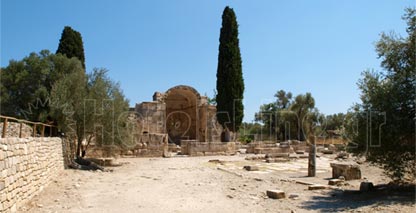 ARCHAEOLOGICAL SITE of GORTYNA
ARCHAEOLOGICAL SITE of GORTYNA
Gortyna is one of the most important cities of Crete. It has a history of 6,000 years and is one of the largest archaeological sites in Greece. It is located in south-central part of Crete, 40 minutes south of the city of Heraklion, on the road leading in Matala and Phaistos. It is 1 km from the village of Agii Deka.
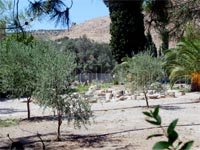
It took its name, according to the tradition, from Gortyna, son of the king of Phaistos, Radamanthi, and brother of Minos, who also found it. Another view holds that the founder is Gortyna, coming-this time-from Tegea of Arcadia of Gortynia. A third version says that the city was founded by the queen of Crete and mother of King Taurus, Gortyna.
Gortyna was among the first areas that attracted the interest of researchers and archaeologists, including the years of Ottoman rule in the late 19th century, at a time when the existence of the Minoan culture was still a myth.
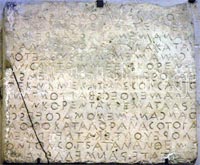
In 1884, it was found and rescued the Great Inscription of Joseph Hatzidakis, Stephen Xanthoudides and of the Italian Federico Halbherr.
That was the reason for the start of excavations in Gortyna. The work began after 1898, when Crete became autonomous, by the Italian Archaeological Mission in collaboration with the Archaeological Service, and lasted until 1940. The excavations revealed large architectural projects and findings. A large part of the Roman city has not been excavated yet. The most important findings are at the Archaeological Museum of Heraklion, while in the next few years will become the establishment of the Archaeological Museum of Messara, which will accommodate them.
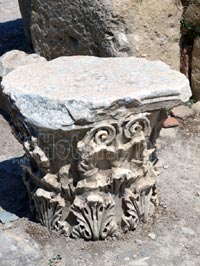
The area of Gortyna habitated the last years of the Neolithic and Minoan times. Since the mid-first millennium BC and then, Gortyna succeed Phaistos and dominated in Messara, having as a center the citadel with Patron the temple of Minerva.
After the conquest of Crete by the Romans in 67 BC, while Gortyna was friendly adjacent to Rome, became the capital of Crete replacing Knossos. It retained the position of the capital up to the Arab conquest in 828 BC, when the capital moved to Candakas, the curent Heraklion.
It reached its zenith in the 2nd century AD. The early Christian centuries (7th century AD.) were the last era of its flourishing. In 796 BC, it almost destroyed by an earthquake.
The archaeological site of Gortyna
Gortyna is characterized by the Church of St. Titus, which is also an archaeological site, the Conservatory and the Plane-tree. Noteworthy, however, is the room with the laws of Gortyna, the early Christian church of Crete and Praetorium, the seat of the Roman governor of Crete.
The Plane-tree in Gortyna
It is located at the bottom of the site and is evergreen, and that makes it a rare subspecies because each plane-tree is deciduous. In Crete, around 50 of these trees have been recorded.
The Plane-tree is associated with the Abduction of Europa, daughter of the king of Phoenicia, by Zeus, who fell in love and he appeared in front of her transformed into a bull. She sat on his back and he left, taking her with him. So they arrived in Gortyna, where he was revealed himself, and mated under the plane-tree. Their children were the 3 legendary kings of Crete: Minos, Rhadamanthys and Sarpedon.
The Conservatory
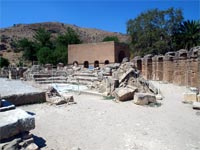
The Conservatory was formed the first century AD, taking the place of the parliament of Gortyna. There, were organized musical and theatrical performances and recitations. It is top of its kind, as well as the oldest conservatory in Crete. It consists of three parts: The Hollow: The space where the spectators sit.
The Orchestra: The semicircular open space, encrusted with white and blue marble.
The Scene: The elevated rectangular area opposite Hollow, with 3 entrances and square niches decorated with statues. Behind the Scene was the backstage, with mosaic floors – an area which was used for burials after-time.
The Praetorium
The Praetorium impresses with its size, the number of buildings and the splendor, as the ruins reveal. It served as headquarters and residence of the governor of the Roman province of Crete and of Cyrenaice.
Its first phase determined in the first century AD while there were 8 conversions during centuries. The archaeological excavations have revealed a complex of baths, a temple dedicated to Avgoustos, a colonnaded courtyard, a courthouse and other sites of various functions.
